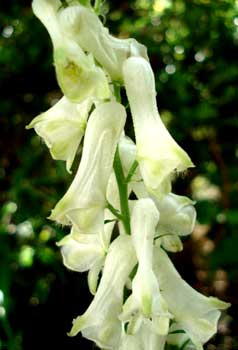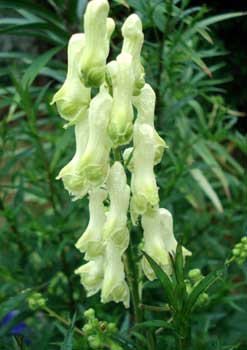
'Ivorine' Northern Monkshood
The united vessel of their blood
Mingled with venom of suggestion
As force perforce, the age will pour it in
Shall never leak, though it do work as strong
As aconitum or rash gunpowder.
-Henry IV
William Shakespeare
Aconitum septentrionale 'Ivorine' is a white-flowering monkshood which closely resembles A. lamarckii but nicer because that one's flowers are an unimpressive yellowish green & don't show themselves as boldly.William Shakespeare
'Ivorine' is a recipient of the Award of Garden Merit from the Royal Horticulatural Society. The species is lavender-blue & less often seen in nursery stocks, a native from Northern Europe eastward far into Russia.
 It likes moist well-draining humusy soil, becoming drought-hardy after it has settled in a couple years. It adapts more readily than most monkshoods to imperfect conditions & can even succeed in clay, though not as happily.
It likes moist well-draining humusy soil, becoming drought-hardy after it has settled in a couple years. It adapts more readily than most monkshoods to imperfect conditions & can even succeed in clay, though not as happily.It dislikes direct sun but with extra watering & some mulching protection for the root crown which hates to get sun-heated, it'll do fine. It's just overall an easy plant to grow, & ultra cold hardy to Zone 3.
Monkshoods are highly toxic. There are reports that this one is not, though I believe this to be an error, & I'll go into a little detail about this to warn against those references throughout the web that it has been used as a comestible in northern Europe, which strikes me as improbable since some monkshood toxins are not easily broken down by heat.
So I certainly wouldn't test it, as if the reports are as wrong as I expect, say goodbye to this world. The species contains such highly toxic chemicals as lapkpaconitine, septentrionine, cynoctonine, & a whole array of deadly alkaloids, most concentrate in the roots. These could definitely induce fatal heart-attack, &am crystalized extracts of this species have been used in Russia, in carefully measured doses, as an antiarrhythmic akin to digitalis.
Buds are attractive in June & fully open in July. The clump will spread, very slowly, to a foot & a half. Division is possible after three to five years, though frankly monkshoods don't like being dug up & it's better to plan for a permanent location for the eventually-giant clump, which rarely "tire" in the middle but just get bigger & more gorgeous each year.
Rising from a bushy clump of leaves are upright spikes with very-numerous narrow helmet-flowers. These spikes rise to three or even four feet & are not too prone to lodging, but may need staking.
Continue to:
Aconitum x henryi 'Sparks'
Aconitum x henryi 'Sparks'